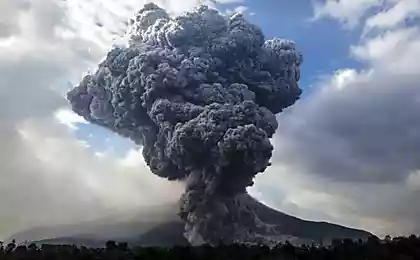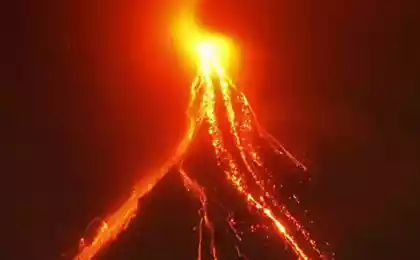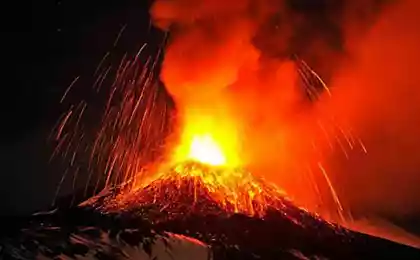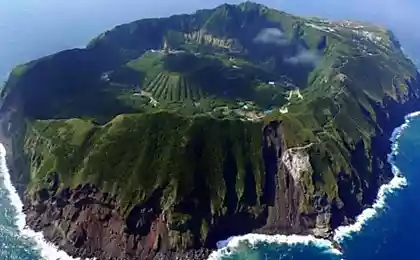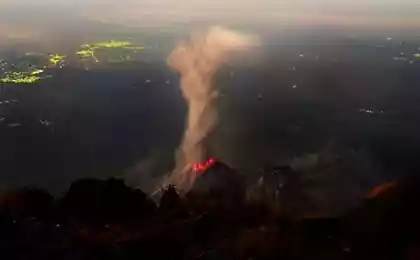550
Aogashima - a city inside an active volcano
About 230 years ago the eruption destroyed nearly half the city's population. But people continue to live and hope for the best.
1785 will forever remain in the memory of the inhabitants of Aogashima - a small island three hundred kilometers south of Tokyo. That year there was the worst disaster in the history of the island. And although its present inhabitants had not yet been born, the memory of this event is passed from mouth to mouth.
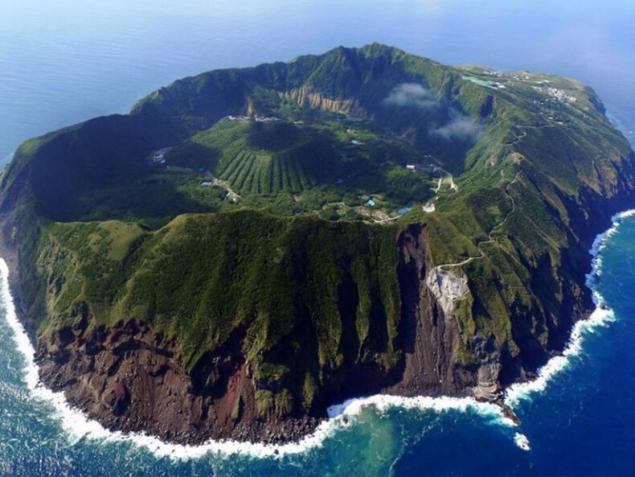
According to legend, May 18 the ground began to shake. From the crater of the volcano felled giant clouds of gas and smoke into the sky flying stones, dirt and other debris. By the beginning of June 4 residents have realized that it is necessary to leave the island, but only half of the 327 people managed to successfully evacuate the rest were killed.
At present the volcano is still considered active. Behind it conducts surveillance Japan Meteorological Agency, is responsible for monitoring all active volcanoes in Japan. Today the population of the island knows that history may repeat itself, but prefers to take risks.

One of these is a brave public servant Masanubu Yoshida, who lives on the island of the past fifteen years. He's trying not to spend too much time thinking about the possibility of a new eruption. In the end, since it's been 230 years, so long as the odds are in his favor.
"No one can overcome nature" - says Yoshida. So instead of thinking about the probabilities, he prefers to focus on the benefits of living in a lush paradise, which was formed from the remains of the four craters overlapping centuries ago. Most of the settlements located inside the outer wall of the funnel.
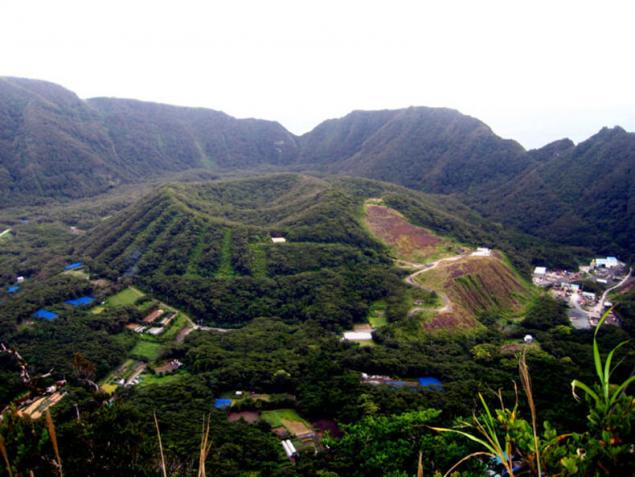
Since the island is in the middle of the Philippine Sea, fishing - a very popular activity among local residents. They are also fond of mountaineering, hiking and swimming, although steep rocky cliffs of the island complicate the approach to water everywhere except in the harbor.
Due to the volcano island is rich in hot springs and geothermal energy. One of the tourists visiting the field of natural saunas so described his experience: "You can bring food with them, and prepare it, simply by placing one on top of the steam holes." In the sauna, there is always a large number of ready kastryulek and pans for cooking boiled eggs and other food.

Although Yoshida works in the office, most of his neighbors - the fishermen and farmers. The island has a factory for the production of calcium-rich salt, a few shops, a hotel, shop. Residents are grown herbs and vegetables and produce shochu - a strong alcoholic drink, which is one of Japan's national symbols. Despite the small size of the island, most of its inhabitants prefer not to navigate on foot or by bike and by car, because thanks to the tropical climate, the weather can often bring a surprise in the form of a strong wind or a sudden rain.
On the island there are few roads, mostly winding around the center of the island. But in spite of urban life oases Aogashima in stark contrast with the main part of Japan. On duty Yoshida accounts several times a year to visit Tokyo, performing trehsotkilometrovoe journey by sea by ferry. During these visits, the 13 million city he feels is
"I often visit large Affairs ground, but I was afraid of overpopulation - there are just too many people, - he says. - On our island we can feel the greatness of nature, you will never feel in the big city »
. Fortunately for Yoshida and his neighbors, the volcano is staying calm. Japan Meteorological Agency in 2007 began issuing warnings of volcanic activity, and over the 9 years to Aogashima has not issued a single warning. And while each new day of the islanders - is one more day of life in paradise.
1785 will forever remain in the memory of the inhabitants of Aogashima - a small island three hundred kilometers south of Tokyo. That year there was the worst disaster in the history of the island. And although its present inhabitants had not yet been born, the memory of this event is passed from mouth to mouth.

According to legend, May 18 the ground began to shake. From the crater of the volcano felled giant clouds of gas and smoke into the sky flying stones, dirt and other debris. By the beginning of June 4 residents have realized that it is necessary to leave the island, but only half of the 327 people managed to successfully evacuate the rest were killed.
At present the volcano is still considered active. Behind it conducts surveillance Japan Meteorological Agency, is responsible for monitoring all active volcanoes in Japan. Today the population of the island knows that history may repeat itself, but prefers to take risks.

One of these is a brave public servant Masanubu Yoshida, who lives on the island of the past fifteen years. He's trying not to spend too much time thinking about the possibility of a new eruption. In the end, since it's been 230 years, so long as the odds are in his favor.
"No one can overcome nature" - says Yoshida. So instead of thinking about the probabilities, he prefers to focus on the benefits of living in a lush paradise, which was formed from the remains of the four craters overlapping centuries ago. Most of the settlements located inside the outer wall of the funnel.

Since the island is in the middle of the Philippine Sea, fishing - a very popular activity among local residents. They are also fond of mountaineering, hiking and swimming, although steep rocky cliffs of the island complicate the approach to water everywhere except in the harbor.
Due to the volcano island is rich in hot springs and geothermal energy. One of the tourists visiting the field of natural saunas so described his experience: "You can bring food with them, and prepare it, simply by placing one on top of the steam holes." In the sauna, there is always a large number of ready kastryulek and pans for cooking boiled eggs and other food.

Although Yoshida works in the office, most of his neighbors - the fishermen and farmers. The island has a factory for the production of calcium-rich salt, a few shops, a hotel, shop. Residents are grown herbs and vegetables and produce shochu - a strong alcoholic drink, which is one of Japan's national symbols. Despite the small size of the island, most of its inhabitants prefer not to navigate on foot or by bike and by car, because thanks to the tropical climate, the weather can often bring a surprise in the form of a strong wind or a sudden rain.
On the island there are few roads, mostly winding around the center of the island. But in spite of urban life oases Aogashima in stark contrast with the main part of Japan. On duty Yoshida accounts several times a year to visit Tokyo, performing trehsotkilometrovoe journey by sea by ferry. During these visits, the 13 million city he feels is
"I often visit large Affairs ground, but I was afraid of overpopulation - there are just too many people, - he says. - On our island we can feel the greatness of nature, you will never feel in the big city »
. Fortunately for Yoshida and his neighbors, the volcano is staying calm. Japan Meteorological Agency in 2007 began issuing warnings of volcanic activity, and over the 9 years to Aogashima has not issued a single warning. And while each new day of the islanders - is one more day of life in paradise.




